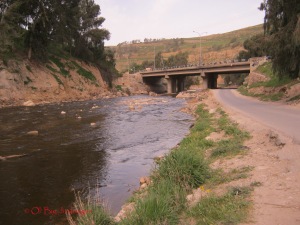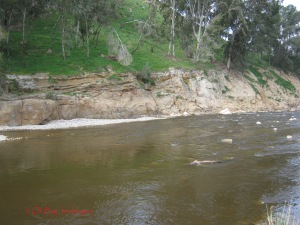 The Yabbok River, now known at the Zarqa River is associated with the biblical Jabbok River. It arises from springs near Amman (biblical Ammon) and flows 73 kilometers (45 miles) through the wide and deep valleys to empty into the Jordan River.
The Yabbok River, now known at the Zarqa River is associated with the biblical Jabbok River. It arises from springs near Amman (biblical Ammon) and flows 73 kilometers (45 miles) through the wide and deep valleys to empty into the Jordan River.
Thanks to overuse and heavy pollution the river is in a very poor condition. Recently, the Ministry of the Environment and the Royal Society for the Conservation of Nature have placed it in a high priority position for restoration and rehabilitation.
The 30 million year old river originates near ‘Ain Ghazal, an archaeological site dating back to the Neolithic period (10,200-2,000 BCE), the latter part of the Stone Age.
 While it wasn’t specifically mentioned in the Bible, it is believed that Prophet Abraham probably traveled along the Jabbok on his way from Haran to Shechem.
While it wasn’t specifically mentioned in the Bible, it is believed that Prophet Abraham probably traveled along the Jabbok on his way from Haran to Shechem.
The first mention of the Jabbok was in the story of Jacob’s wrestling match with an angel and his subsequent reunion with his brother, Esau. “And he rose up that night, and took his two wives, and his two handmaids, and his eleven children, and passed over the ford of the Jabbok.” (Genesis 32:22)
In biblical times it was the border separating Reuben and Gad from Ammon. “And unto the Reubenites and unto the Gadites I gave from Gilead even unto the valley of the Arnon, the middle of the valley, and the border thereof, even unto the river Jabbok, which is the border of the children of Ammon.” (Deuteronomy 3:16) and “And Israel smote him with the edge of the sword, and possessed his land from the Arnon unto the Jabbok, even unto the children of Ammon; for the border of the children of Ammon was strong. And Israel took all these cities: and Israel dwelt in all the cities of the Amorites, in Heshbon, and in all the towns thereof.” (Numbers 21:24-25) The Israelis occupied Ammon as far as Dhiban and Madaba.
 Some time later, the king of Ammon made an unsuccessful attempt to reclaim his borders. (Judges 11:13) So, the Gileadites went to Jephthah, whom they had previously exiled because of the fact he had been born of a harlot, and begged him to lead the fight against the king of Ammon. After extracting promises from them to allow him back into Gileadite society, he agreed and was successful in the war.
Some time later, the king of Ammon made an unsuccessful attempt to reclaim his borders. (Judges 11:13) So, the Gileadites went to Jephthah, whom they had previously exiled because of the fact he had been born of a harlot, and begged him to lead the fight against the king of Ammon. After extracting promises from them to allow him back into Gileadite society, he agreed and was successful in the war.
Other mentions of the river can be found in 2 Samuel 2:8 that tells about Ish-Bosheth, the son of Saul. When his father died, Ish-Bosheth fled and ruled from Mahanaim. “But Abner the son of Ner, commander of Saul’s army, took Ish-Bosheth the son of Saul and brought him over to Mahanaim,”. Later, David was forced to run from his son, Absalom’s revolt and he ran to the same place. “Then David came to Mahanaim. And Absalom crossed the Jordan with all the men of Israel… When David came into Mahanaim, Shobi the son of Nahash from Rabbah of the Ammonites,… brought beds, basins, and earthen vessels, wheat, barley, flour, parched grain, beans and lentils, honey and curds and sheep and cheese from the herd, for David and the people with him to eat, for they said, ‘the people are hungry and weary and thirsty in the wilderness’”. (2 Samuel 17:24-29)
 The river has a long and colorful history. It’s very sad that it has been allowed to be so abused by pollution. Unfortunately, the ecosystem has been allowed to disintegrate for so long that there is no longer any hope of a “quick fix”. But, when it is complete it will play a major role in the social and economic development of the area.
The river has a long and colorful history. It’s very sad that it has been allowed to be so abused by pollution. Unfortunately, the ecosystem has been allowed to disintegrate for so long that there is no longer any hope of a “quick fix”. But, when it is complete it will play a major role in the social and economic development of the area.
Hopefully, at the end of the three year project we will see some radical improvements to this valuable and historical resource.
